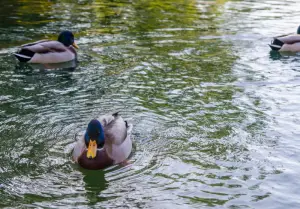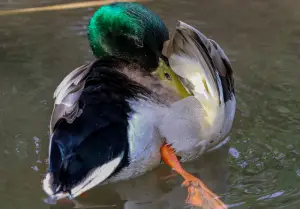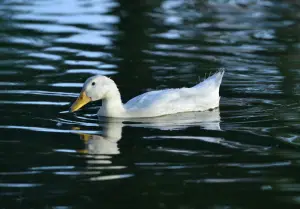Do Ducks Float?
Have you ever spent an afternoon sitting on a park bench, watching the ducks glide across the pond? If so, you know that ducks will appear to be able to float and glide across the water with ease, with little or no effort expended. While we cannot see what is happening under the water, you may be wondering how it is that ducks can so effortlessly stay afloat.
How is it that ducks float? Ducks are able to float due to their natural buoyancy – the fact that they are lighter in mass than the water that they displace. This buoyancy is the result of three traits unique to waterfowl: their hollow bones, the air sacs that their bodies contain, and their oiled (and therefore water-repellent) feathers.
Most of us might take a duck’s buoyancy in the water for granted, but you might find yourself fascinated when learning about the biomechanics involved in this ability. To understand how ducks are able to use these unique characteristics to stay afloat, we must first familiarize ourselves with duck anatomy. Read on to learn more about how the duck’s bodily mechanisms allow it to float in the water.
Reasons That Ducks Float
Before we understand what it is that gives a duck the ability to float, we first must understand what it means to float. The ability to float above the water without external effort is known as “buoyancy”. Merriam-Webster defines buoyancy as “the tendency of a body to float or rise when submerged in fluid”.
Let’s get scientific for a moment. The physical law of buoyancy, also known as “Archimedes’ principle” states that a body submerged in fluid, at rest, is moved by an upward force that is equal in measurement to the weight of the fluid displaced by the body.
For a body to be buoyant then, it must weigh less than the mass of the displaced fluid. Ducks and other waterfowl, as we will learn, have a number of innate characteristics that allow them the relatively light weight required for buoyancy.
Reason Ducks Float #1: Hollow Bones 
Human bones are dense and filled with bone marrow. Ducks, like other birds, instead have hollow bones (birds also have bone marrow, which is necessary in the production of blood cells, but it is limited to specific areas of the bones). Hollow bones are one of the anatomical characteristics that allow a duck to float in the water.
While the assumption can be reasonably made that hollow bones result in buoyancy because they are lighter than other bones, there is more to it than this. Avian bones weigh the same, if not more, than the bones of similar-sized animals. This is because the fragility of hollow bones is offset by the denser outer walls required to protect them from easily fracturing.
So if hollow bones are no less dense than the bones of other animals, how is it that they contribute to buoyancy? The majority of a bird’s bones are filled with air sacs, which are literally an extension of a bird’s lungs.
As a duckling grows, its lungs expand into its bones. This is an evolutionary trait that allows a bird to take in enough oxygen when flying. Because of these air sacs, birds can actually take in oxygen while both inhaling and exhaling.
While hollow bones are necessary for flight, they also contribute to a duck’s ability to float in the water simply because of the additional air that is in the body. As we’ll learn, hollow bones aren’t the only mechanism for increased oxygen (and therefore, air) – ducks have additional air pockets throughout their bodies.
Reason Ducks Float #2: Bodily Air Sacs
Ducks have lungs, like humans. But unlike humans, they also have additional air sacs throughout the body that, with the lungs, make up the complex avian respiratory system. As is the case with hollow bones, these air sacs have evolved in waterfowl and other birds to aid in flying – the contribution that it makes to floating can be considered as a secondary benefit.
These additional air sacs throughout the body allow a bird to have an uninterrupted flow of oxygen at all times. This is beneficial and necessary in a flying species, as birds require more oxygen when in the air as opposed to when on the ground. Its contribution to buoyancy is the same as with hollow bones – the additional air in the body allows the duck to float as it helps to make the bird lighter than the water that its body displaces.
Reason Ducks Float #3: Water-Repellent Feathers 
If you spend any amount of time watching ducks, you will see that they spend a significant amount of time each day preening themselves. When preening, what they are actually doing is oiling their feathers. At the base of a duck’s tail is the uropygial gland.
This gland produces an oil that a duck will dip into with his bill and spread all over his body, thoroughly coating his feathers and rendering them water-resistant.
Anyone who has tried to lift a bucket of water knows that water is very heavy, as it is very dense. Any porous object will weigh significantly more after being submerged in water – just think about the difference in weight between a dry sponge and a wet sponge. While feathers are lightweight (ever heard the saying “light as a feather”?) they are porous objects, and left untreated will weigh more when submerged in water.
As oil and water don’t mix, by naturally coating their feathers in oil they are preventing their feathers from absorbing water. Water will quite literally roll off a preened duck’s back. By preventing their feathers from becoming water-logged, they are contributing to the lightness that allows them to float.
This ability to repel water holds another advantage – by protecting the duck’s skin from the coolness of the water, a duck is more effectively able to maintain its body heat, allowing it to swim in water that is much colder than we humans would be able to tolerate.
Must A Duck Paddle To Stay Afloat?
There are many inspirational quotes involving the composure of a duck above water combined with a flurry of paddling under the water. As Michael Caine once said, “Be like a duck. Calm on the surface, but always paddling like the dickens underneath”. These quotes encourage people to maintain a calm facade even while furiously trying to keep from drowning.
Without getting into the question of whether this advice can cause more harm than good, we know that these quotes are factually incorrect. Ducks do not need to paddle at all to stay afloat – in fact, ducks are able to relax and sleep while floating. The only situations in which a duck needs to paddle in the water is to steer or fight a current.
At What Age Can A Duck Float? 
Just because a duck’s body has evolved to enable it to float does not mean one should toss a newly hatched duckling into the water and expect it to thrive. While ducklings are born with the hollow bones and air sacs that contribute to their buoyancy, their uropygial glands are not fully functional until they are 4 – 8 weeks of age.
Ducklings hatched under the care of a duck are at an advantage in this regard – mother ducks will use their own uropygial glands to coat the down of their ducklings, giving them some protection from the water. Ducklings hatched under an incubator have no such assistance – they will not be able to oil their own feathers until they have a functioning oil gland.
For this reason, one should proceed with caution when introducing young ducklings to the water. They should always be under supervision and should be started with very shallow warm water – shallow enough so that they can put their feet down and stand on the bottom when they become tired.
It is also important to keep them warm once they exit the water. While this may cause you to think it best to keep your ducklings from water until they are fully feathered and have functional uropygial glands, research shows that the earlier a duckling is exposed to water, the earlier it will learn the art of preening.
A Duck’s Unique Anatomy Provides The Ability To Float
As we can see, the duck’s ability to float is multi-faceted and delicately balanced. When one of these systems is compromised, buoyancy will be adversely affected. It is important, therefore, to regularly watch your birds swim so that you will be able to notice if anything is not right – such as a ruptured air sac or a problem with the uropygial gland.
Aside from illness or injury, however, a duck’s unique anatomy will allow him to float effortlessly through the water. Next time you are watching your ducks serenely glide across their pond, you can think about the fascinating functions that allow them to do so.

